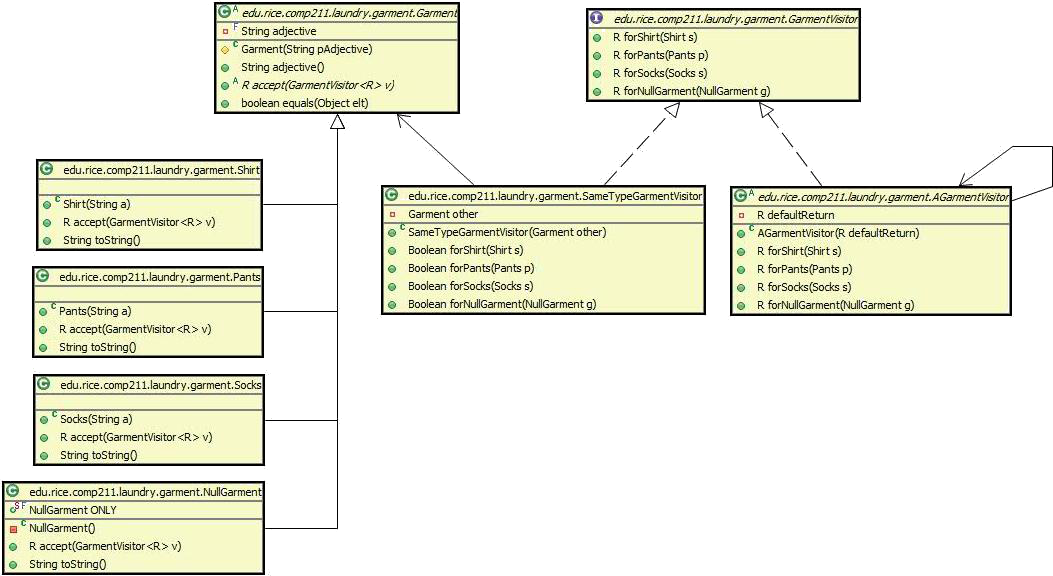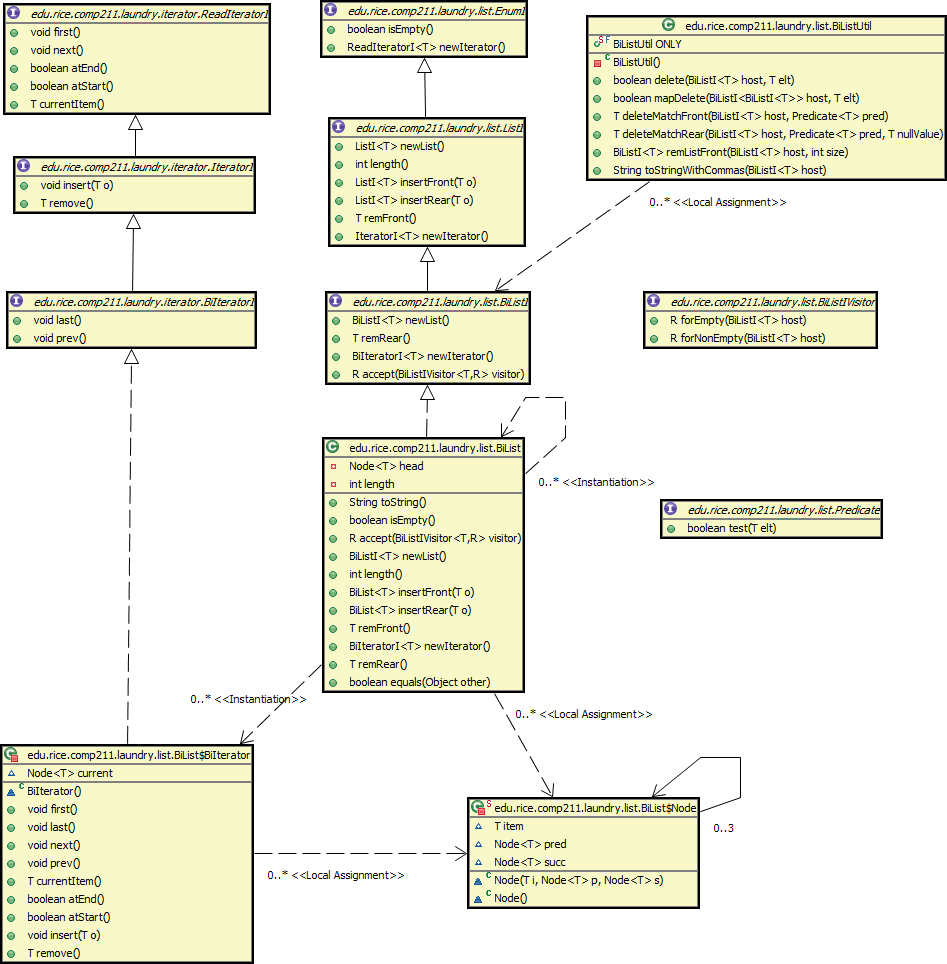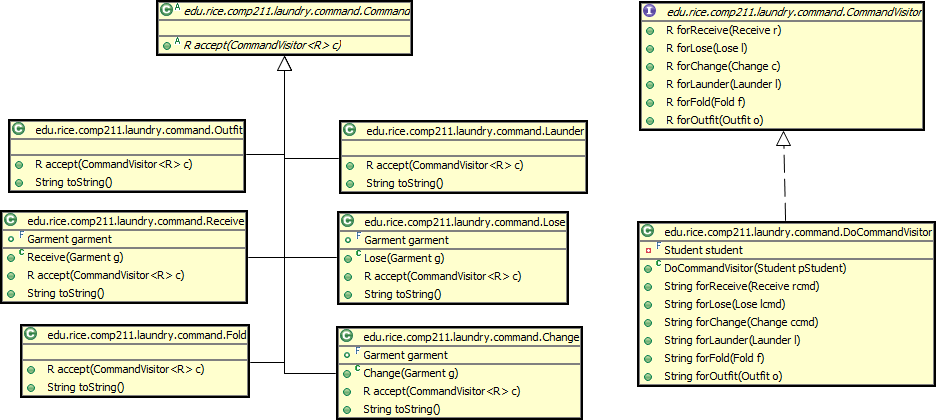HW10 Code Details
Most of the supplied code is support code that you do not have to worry about. You are certainly free to use whatever you wish, but only the classes listed here should be needed.
You WILL need to make anonymous inner classes and possibly some named classes if you feel you need them. The staff's solution only uses anonymous inner classes, so it definitely can be done that way.
In viewing the UML diagrams below, keep in mind that a class or interface always inherits all of the methods of its parents, i.e. everything above it. Just because a class or interface only shows 2 methods in its little box in the UML diagram doesn't mean that's all the methods it has--look at all the methods in its superclasses/superinterfaces too!
Don't forget to
importa package before attempting to use any of its classes.Check the Javadoc comments of each class to learn more about what each class does.
Student Package
A student is wearing a shirt, pants and socks. The student also has references to several lists (ordered piles) of garments: clean shirts, clean pants, clean socks, a dirty clothes pile and a laundry room which is a list of list of garments because it represents the collection of multiple loads of laundered garments that have been cleaned, but not yet folded and returned to the individual clean garment piles.
Garment Package
Garments are of 4 types:
Shirt- represents shirts of various typesPants- represents pants of various typesSocks- represents socks of various typesNullGarment- represents the absence of a garment, such as one might get on a failed search for a garment.
All Garments have an "adjective" field that is used to differentiate different instances of Shirts and Pants and Socks, e.g. a "blue" Shirt vs. a "red" Shirt.
Garments support a visitor, GarmentVisitor, which has cases for each type of visitor. NEVER test for the type of a Garment object! Always delegate to it by having the garment object accept a visitor whose different cases provide the garment-type-dependent processing you desire.
AGarmentVisitor is a convenience class that provides concrete default behavior for all the cases. If you only need to specify one or two cases and just return a default value for the rest, create your visitor by sub-classing AGarmentVisitor and overriding only the cases you desire. Note that the AGarmentVisitor's constructor requires an input parameter, the default value to use for the non-overridden cases.
Here's an example of using AGarmentVisitor to write a little visitor to return either "Not a Sock!" or "Got some socks!" depending on whether the visitor is accepted by a Socks object or some other kind of Garment object.
GarmentVisitor isSockGarmentVisitor = new AGarmentVisitor<String>("Not a Sock!") {
public String forSocks(Socks sockHost) {
return "Got some socks!";
}
}
aShirt.accept(isSockGarmentVisitor) --> "Not a Sock!"
aPants.accept(isSockGarmentVisitor) --> "Not a Sock!"
aNullGarment.accept(isSockGarmentVisitor) --> "Not a Sock!"
aSock.accept(isSockGarmentVisitor) --> "Got some socks!"
The SameTypeGarmentVisitor is a utility visitor that can be used to return a true or false if two Garment objects are the same type, i.e. a Shirt and a Shirt or a Pants and a Pants, regardless of their "adjectives".
Lists package
BiLists are used to represent the various piles of clothes or a collection of piles of clothes (the laundry room).
Using BiList:
BiList<Garment>is a pile of clothes.insertFront()andremFront()are the methods to insert and remove from the top of the pile respectively.insertRear()andremRear()are the methods to insert and remove from the bottom of the pile respectively.newIterator()is a factory method that will create an iterator for you specifically for that list, initialized to point at the first (top) element of the list. Do NOT try to make an iterator by instantiating one yourself!{[BiLists}} (
the super-interface BiListI actually) acceptBiListIVisitorsthat can be used to perform operations that depend on whether the list is empty or not. That is,BiListIVisitorhas 2 cases,forEmptyandforNonEmpty.BiListsalso have anisEmpty()method that can be used for imperative/procedural-style conditional processing based on the list's emptiness. Using a delegation-style processing using theBiListIVisitoris recommended however and will result in cleaner code in some cases.
Using the BiIteratorI<Garment> iterator a BiList<Garment> creates:
- The
BiListwill initialized the iterator to point to the top of the list. atEnd()will return true if you are at the end of the list, so your while loop's conditional should have something like "while(!myIterator.atEnd()) {....}"- Read the data at the current iterator location by using
currentItem(). - The iterator, unlike most iterators in the world, supports mutation, so
insert()andremove()will mutate the list at the current iterator location. Be VERY CAREFUL when advancing the iterator after these operations or you will skip elements!! - Typically, a call to
next()will be used to advance the iterator one element towards the bottom of the pile. - You can iterate backwards through the list by using the
prev()method rather thennext(). You'll need to initialize the iterator at the bottom of the pile (end of the list) by first calling thelast()method to set the iterator to the end of the list. The loop conditional should be something like!myIterator.atStart().
BiListUtil is a singleton that provides utility methods that you might find useful for various operations on your lists. It is also a handy source of examples on how to use the BiLists and their iterators.
Command package
Command objects (not to be confused with the Command Design Pattern) are "messages" (in OO parlance) sent to the laundry simulation system to effect particular operations. These operations are described in detail in the previous wiki page. There is one Command sub-class corresponding to each type of operation the simulation supports, namely an Outfit query, Receive a new Garment item, Change a particular type of garment worn, Lose a specific Garment, Launder the pile of dirty clothes (to with maximum bounds), and Fold a pile of clean clothes and return them to their clean piles.
Every Command object can accept a CommandVisitor which has cases for each possible type of Command.
DoCommandVisitor is the visitor that you have to write (fill in the missing code) for this assignment. Other than the student field, your implementation may have additonal fields and private utility methods that you decide you need for your implementation. Thus, your DoComandVistor may appear slightly different than what is shown here.



